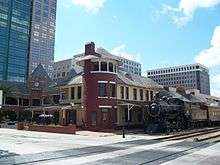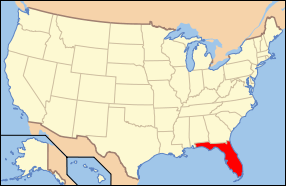Church Street Station (Orlando)
Church Street Station | |||||||||||
|---|---|---|---|---|---|---|---|---|---|---|---|
| SunRail commuter rail station | |||||||||||
 The Old Orlando Railroad Depot built in 1889 still stands alongside the modern SunRail station | |||||||||||
| Location |
4 Depot Place and West Church Street Orlando, Florida | ||||||||||
| Owned by | Florida Department of Transportation | ||||||||||
| Platforms | 2 side platforms | ||||||||||
| Tracks | 2 | ||||||||||
| Connections |
| ||||||||||
| Construction | |||||||||||
| Structure type | At-grade | ||||||||||
| Parking | Street and garage parking | ||||||||||
| Bicycle facilities | Yes | ||||||||||
| Disabled access | Yes | ||||||||||
| Other information | |||||||||||
| Fare zone | Orange | ||||||||||
| History | |||||||||||
| Opened | 1889[2] | ||||||||||
| Rebuilt | 2013 | ||||||||||
| Traffic | |||||||||||
| Passengers (2014) | 435 daily | ||||||||||
| Services | |||||||||||
| |||||||||||
|
Old Orlando Railroad Depot | |||||||||||
  | |||||||||||
| Location | Orlando, Florida, USA | ||||||||||
| Coordinates | 28°32′24″N 81°22′50″W / 28.54000°N 81.38056°WCoordinates: 28°32′24″N 81°22′50″W / 28.54000°N 81.38056°W | ||||||||||
| Built | 1889[2] | ||||||||||
| Architect | T. B. Cotter[3] | ||||||||||
| Architectural style | Eclectic Victorian,[2] Shingle Style[3] | ||||||||||
| NRHP reference # | 76000604[3] | ||||||||||
| Added to NRHP | April 22, 1976 | ||||||||||
Church Street Station, also called the Old Orlando Railroad Depot, is a historic train station and commercial development in Orlando, Florida. The historic depot and surrounding buildings house a retail and entertainment center. The complex also contains a stop for SunRail, the commuter rail service of the Greater Orlando area.
The station building was constructed in 1889 by South Florida Railroad. It served several different railroads until 1926, when passenger services transferred to what is now the Orlando Health/Amtrak station. In the 1970s, the station and nearby buildings were bought and developed into an entertainment center. After its original owner sold the development in 1989, Church Street Station experienced a period of decline. In 2013, St. Petersburg businessman Mark Ferguson signed a 20-year lease with an option to purchase in hopes of turning the property around.[4]
Station
Atlantic Coast Line Railroad

The station was originally built by the South Florida Railroad in 1889 (although some sources say it was built in 1890) to serve Orlando. The South Florida Railroad was bought out by the Plant System in 1893, which in turn was taken over by the Atlantic Coast Line Railroad in 1902. The station also served the Tavares, Orlando and Atlantic Railroad and the Orlando and Winter Park Railway. In 1926 passenger operations were transferred to Orlando Health/Amtrak station. The Church Street depot still survives to this day on the National Register of Historic Places.[3]
SunRail
The SunRail commuter rail project uses the historic Church Street Rail Depot as one of three stops in downtown Orlando.[5] A new platform on the same side of the tracks was built down the block from the Church Street Station, within walking distance of Orlando City Hall. Church Street Station is typical of most SunRail stations featuring canopies consisting of white aluminum poles supporting sloped green roofs and includes ticket vending machines, ticket validators, emergency call boxes, drinking fountains, and separate platforms designed for passengers in wheelchairs. The station is located along the former CSX A-Line (originally constructed by the South Florida Railroad) and is one of two located in the central business district, providing easy access to the new Dr. Phillips Center for the Performing Arts and hotel development within the same block; Camping World Stadium, which recently underwent a complete renovation; the proposed Orlando City Stadium, future home of the Orlando City Lions MLS soccer club; and the new Amway Center and proposed entertainment complex, home of the Orlando Magic NBA team[6]
Night club complex
Based on the Rosie O'Grady's/Seville Quarter complex that opened in Pensacola, Florida in the late 1960s by entrepreneur Bob Snow, Rosie O'Gradys/Church Street Station in Orlando saw great popular success in the 1970s and 1980s as it operated as an attraction offering admission to multiple nightclubs of various formats) facilitating "club hopping" for a single price in a monolithic location. It spanned both sides of Church Street and both sides of the railroad tracks.[7] Walt Disney World emulated the successful formula, opening its own Pleasure Island club district amidst Church Street Station's peak years of success, as did Universal Studios Orlando with its "City Walk" complex. The attraction's developer proceeded to develop a similar venue in Las Vegas, "Main Street Station" that at inception shared many club concepts with the Orlando facility.
As an attraction, Church Street Station eventually experienced a steep decline in attendance and had largely closed as a club-hop by the end of the 1990s.[7]
Several attempts have been made by multiple owners to re-create the success of the 1970s and mid-1980s. Today in the immediate vicinity there are a number of restaurants and bars, an event venue, high-rise apartments and condominiums, and a franchise of the gay-themed restaurant Hamburger Mary's.
With foreclosures and serial disappointments duplicating the successes of the past, the future of the development remains questionable. A source of probable stimulus will likely occur with the new Amway Center. Across Interstate 4, Orlando's new entertainment arena has been constructed on Church Street, within close walking distance of Church Street Station. The arena, home to the Orlando Magic of the NBA, opened to the public on October 1, 2010.[8] Nearby businesses anticipate a boost in traffic as arena customers hit the streets before and after events.
SunRail revived the station in 2014 as a commuter rail stop.[6]
The former Rosie O’ Grady’s Good Time Emporium restaurant and entertainment venue — sold in June 2010 for $2.2 million to downtown commercial property owners Frank Hamby and Margaret Casscells. The new owners are transforming the 14,335-square-foot (1,331.8 m2) building into the New Orleans-style MoJo Bar & Grill.
Timeline

- 1972: Entrepreneur Bob Snow announces plan for a downtown Orlando entertainment complex.
- 1974: Snow opens Rosie O'Grady's.[7]
- 1976: The station is added to the National Register of Historic Places
- 1982: Cheyenne Saloon & Opera House opens.
- 1985: Church Street Station draws 1.7 million visitors, making it the fourth-largest tourist attraction in the state after Walt Disney World, Sea World and Busch Gardens.
- 1988: Snow sells 50 percent interest in Church Street Station.
- 1989: Snow sells remainder of his interest to a subsidiary of Baltimore Gas & Electric Co.; total cost of the two-step deal: $61 million to $82 million.
- 1994: Church Street Station completes major expansion with a 24,000-square-foot (2,200 m2) Presidential Ballroom for $5.5 million.
- 1998: Church Street Station loses $1 million on revenue of $20.85 million, attracts only 550,000 visitors.
- 1999: Baltimore Gas & Electric sells Church Street Station to Enic PLC, a British firm, for $11.5 million.
- 2001: Enic PLC sells Church Street Station to F.F. South & Co. for $15.9 million
- 2002: Lou Pearlman buys into Church Street Station, later becomes majority owner.
- 2007: Pearlman's financial troubles and Federal indictment and arrest trigger foreclosure lawsuit against Church Street Station.[9]
- 2007: Cameron Kuhn (Developer) purchased Church Street Station at bankruptcy court auction due to financial issues of former owner Lou Pearlman's TransContinental Empire. The property was purchased by Kuhn for $34.1 million.
- 2008: Church Street Station retail opens including The Cheyenne Saloon by Bob Snow, Bliss Ultra Night Club, Brick and Fire Pizza and Wine Company, Ceviche Tapas Restaurant and Bar, The Dessert Lady and Hamburger Mary's.
- 2008: Lender Tremont Net Funding LLC files to foreclose on the property while Mr. Kuhn tries to retain control & negotiate the re-sell of the complex.
- 2010: Historic Church Street Station RR FRISCO 0-6-0 Switcher #3749 Locomotive, which had been on display for many years at the station, was acquired by the City of Orlando and put up for sale.[10]
- 2010: The Amway Center arena opened on West Church Street and is already bringing an influx of business to Church Street vendors and establishments. In the long term the new arena is expected to at least stimulate partial revitalization to the complex.
- 2012: RR FRISCO 0-6-0 Switcher Locomotive #3749 was donated by the City of Orlando to the Florida Railroad Museum and relocated to the latter's facility in Parrish, Florida.[11]
- 2013: St. Petersburg businessman Mark Ferguson signed a 20-year lease with an option to purchase in hopes of turning the property around.[4]
- 2014: SunRail commuter rail begins service with its platform beside the original station[12]
References
- ↑ "SunRail Connections". Retrieved April 2, 2016.
- 1 2 3 "Old Orlando Railroad Depot". Florida Heritage Tourism Interactive Catalog. Florida's Office of Cultural and Historical Programs. February 23, 2007.
- 1 2 3 4 "National Register of Historical Places - Florida (FL), Orange County". National Register of Historic Places. National Park Service. February 23, 2007.
- 1 2 Florida Trend magazine October 2013 page 94
- ↑ Jim Carchidi (April 3, 2014). "A virtual ride to 3 downtown SunRail stops". Orlando Business Journal. Retrieved April 2, 2016.
- 1 2 "Church Street". Retrieved April 2, 2016.
- 1 2 3 "Church Street Station (Orlando Memory)". Archived from the original on February 5, 2012.
- ↑ "MAGIC: Events Center". Orlando Magic. Retrieved July 6, 2009.
- ↑ "Internet Archive Wayback Machine". Archived from the original on September 17, 2009. Retrieved April 2, 2016.
- ↑ "Archived copy". Archived from the original on February 11, 2010. Retrieved February 27, 2010.
- ↑ Orlando Sentinel (February 21, 2012). "Orlando's Church Street steam engine arrives at new home". OrlandoSentinel.com. Retrieved April 2, 2016.
- ↑ Sunrail.com
External links
- Orange County listings, Florida's Office of Cultural and Historical Programs
- Church Street Station (SunRail)
| Wikimedia Commons has media related to Old Orlando Railroad Depot. |

